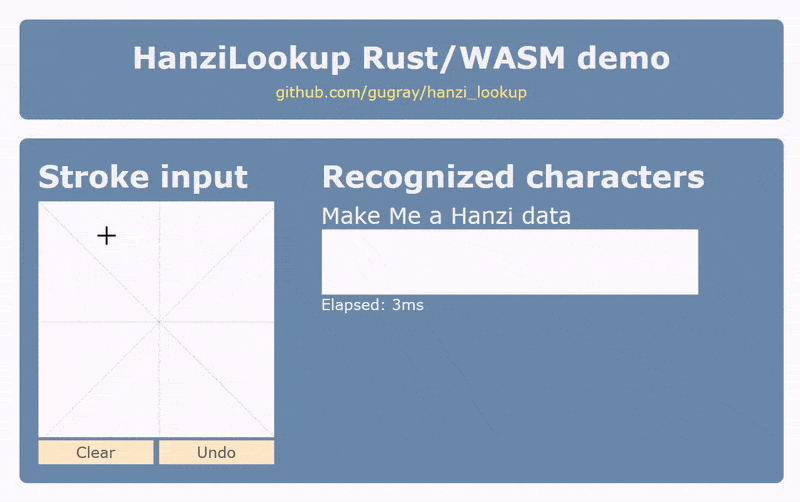Free, open-source, browser-based Chinese handwriting recognition in Rust / WebAssembly
This library is a Rust port of HanziLookupJS, which is itself based on Jordan Kiang's HanziLookup. It contains data derived from Shaunak Kishore's Make Me a Hanzi, and an improved character recognition algorithm.
Online demo: https://gugray.github.io/hanzi_lookup
If you are only interested in using the library in your own project, all you need is hanzi_lookup_bg.wasm and hanzi_lookup.js. These two files are the Rust library's output, and they are included in the web_demo folder.
-
You can use
web_demodirectly if you publish it with a lightweight HTTP server, or even if you just openindex.htmldirectly from the file system. -
The demo project loads the WebAssembly module within a tiny Web Worker, contained in
worker.js. This adds a little extra complexity to the demo because of the event-based communication between the Javascript inindex.htmland the Web Worker. But it's this setup that creates a really smooth user experience by offloading the costly character lookup from the browser's UI thread. -
The demo project includes
drawingBoard.js, which is a simple component for drawing characters on the screen. It is not needed forhanzi_lookupitself to work, and if you do choose to use it, you also need to include jQuery in your page. The compiled library has no external dependencies. -
The WebAssembly module exposes one function, called lookup, accessible by calling
wasm_bindgen.lookup(strokes, limit), as seen inworker.js. The first parameter is an array of strokes. Every stroke, in turn, consists of an array of points. Every point is a two-dimensional array representing its X and Y coordinates. The second parameter is the maximum number of matching characters returned; 8 is a reasonable number here. -
The lookup function returns a JSON string, which you need to convert by
JSON.parse. The result is an array of match objects, each of which has ahanzimember containing the character itself, and ascoremember. The array is ordered by score. -
The compiled library contains all the stroke information embedded as binary data. For details about the origin of the strokes data file and its licensing, see the related sections below.
You need Rust nightly to build the library; I have been compiling with rustc 1.36.0-nightly specifically. In order to generate the WebAssembly module, you also need to install the WASM target wasm32-unknown-unknown, best done by the following command:
$ rustup target add wasm32-unknown-unknown
With this in place, building the library is a two-step process:
$ cargo build --target wasm32-unknown-unknown --release
$ wasm-bindgen .target/wasm32-unknown-unknown/release/hanzi_lookup.wasm --out-dir ./dist --no-modules --no-typescript
I included these steps in build.cmd, a simple Windows batch file. If you are using Linux/Mac, an equivalent shell script can be derived trivially. The second command, wasm-bindgen, is what produces the hanzi_lookup.js file that makes the WebAssembly module comfortably accessible from Javascript.
Some more details if you want to delve deeper:
-
The command-line demo
demo_clialso refers to thehanzi_lookuplibrary but has regular Debug and Release targets; it doesn't require the WASM target. You can simply run it by switching to its folder and executingcargo run. -
You can run the library's unit tests via
cargo testeither from the root or fromhanzi_lookup. -
There is a
launch.jsonfile in .vscode with two configurations, for debugging the library's tests, and for running the command-line demo. If using VS Code, you will need the Rust (rls) plugin. -
A great intro to Rust, WebAssembly and Web Workers is this post: Rust, WebAssembly & Web Workers for speed and profit.
The library no longer includes the original strokes data from Jordan Kiang's HanziLookup. If you're interested, you can still find it in my related project, HanziLookupJS.
The data in in this library is based on mmah.json, which is derived from Make Me a Hanzi's graphics.txt and encodes 9,507 characters. This file is richer than the Jordan Kiang's original because its substroke data also contains the normalized location (center point) of every substroke. The matching algorithm calculates the score accordingly: a substroke that is in the wrong place counts for less. Each substroke is represented by 3 bytes: (1) Direction in radians, with 0-2*PI normalized to 0-255; (2) Length normalized to 0-255, where 255 is the bounding square's full width; (3) Centerpoint X and Y, both normalized to 0-15, with X in the 4 higher bits.
The Rust code loads strokes data from an embedded binary file. You can find the tiny tool I used to convert HanziLookupJS's JSON file into the binary format in the mmah_json_convert folder.
This Rust library is derived from Jordan Kiang's original HanziLookup. In compliance with the original, it is licensed under GNU LGPL.
The strokes data is ultimately derived from the following fonts, via Make Me a Hanzi's graphics.txt and HanziLookupJS's mmah.json:
- Arphic PL KaitiM GB - https://apps.ubuntu.com/cat/applications/precise/fonts-arphic-gkai00mp/
- Arphic PL UKai - https://apps.ubuntu.com/cat/applications/fonts-arphic-ukai/
You can redistribute and/or modify mmah.json or the derived binary file under the terms of the Arphic Public License as published by Arphic Technology Co., Ltd. The license is reproduced in LICENSE-APL; you can also find it online at http://ftp.gnu.org/non-gnu/chinese-fonts-truetype/LICENSE.


